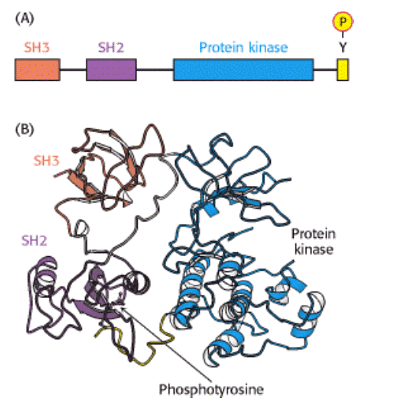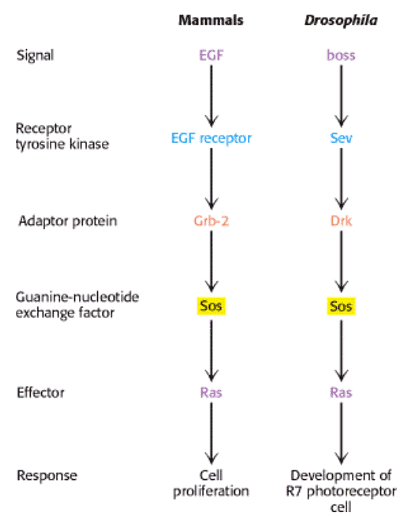Defects in Signaling Pathway and Consequences | Zoology Optional Notes for UPSC PDF Download
Introduction
In light of the intricate nature of signal-transduction pathways, it is not surprising that occasional failures in these pathways can result in pathological or disease states. One such disease closely associated with defects in signal-transduction proteins is cancer, characterized by uncontrolled cell growth. The study of cancer, particularly those caused by viruses, has significantly contributed to our understanding of signal-transduction proteins and pathways.
1. Viral Oncogenes and the Example of Rous Sarcoma Virus:
- Rous sarcoma virus, a retrovirus causing sarcoma in chickens, carries the oncogene v-src.
- The v-src gene encodes a protein tyrosine kinase with SH2 and SH3 domains.
- The v-Src protein, similar to c-Src, is an oncogene, while c-Src is a proto-oncogene.
- Small differences in amino acid sequences lead to the oncogene being constitutively active.
- The inactive conformation of c-Src involves intricate interactions between SH2, SH3, and kinase domains.
2. Activation Mechanisms of Src Protein:
- Src can be activated by displacing the phosphotyrosine residue in the SH2 domain.
- Phosphorylation on the tyrosine residue can be removed by a phosphatase.
- The linker between the SH2 and kinase domain can be displaced by a polypeptide.
- Src responds to distinct signals, exhibiting flexibility in its activation mechanism.
3. Mutation in Oncogenes and Biological Activity:
- Despite more than 90% amino acid sequence identity, the viral oncogene exhibits different biological activity.
- The C-terminal region of c-Src is replaced by a different stretch lacking a key tyrosine residue.
- Mutated protein kinases, including Src, are identified as oncogenes.
4. Acquisition of Mutated Version by Rous Sarcoma Virus:
- Infection allows a viral genome to pick up a host gene with a missing region encoding the last few amino acids.
- The modified gene may confer a selective advantage, favoring viral growth upon introduction to a host cell.
5. Impaired GTPase Activity and Ras in Cancer:
- Mutations in ras genes are common in human tumors.
- Ras proteins cycle between GTP and GDP forms, and mutations often lead to impaired GTPase activity.
- Ras protein remains constitutively active, contributing to cancer progression.
6. Protein Kinase Inhibitors as Anticancer Drugs:
- Overactive protein kinases in cancer cells suggest potential targets for anticancer drugs.
- In chronic myelogenous leukemia (CML), a specific inhibitor of the Bcr-Abl kinase has shown significant efficacy.
- Clinical trials demonstrate more than 90% positive response, offering a distinct approach to cancer chemotherapy.

Cholera Toxin and G-Protein Dysregulation
- Cholera, an acute diarrheal disease, is caused by Vibrio cholera.
- Choleragen, the cholera toxin, consists of B and A subunits.
Mechanism of Action:
- B subunit binds to G M1 gangliosides, facilitating cell entry of the catalytic A subunit.
- A subunit modifies Gs protein, attaching ADP-ribose to an arginine residue.
- Modification stabilizes GTP-bound Gs, perpetually activating the signal-transduction pathway.
- Continuous activation of protein kinase A (PKA) leads to chloride channel opening and Na+-H+ exchanger inhibition.
- Result: Excessive loss of NaCl and water into the intestine.
Clinical Impact:
- Cholera patients may lose as much as twice their body weight in fluid.
- Treatment involves rehydration with a glucose-electrolyte solution.
Pertussis Toxin and G-Protein Inhibition
Pertussis (whooping cough) is caused by Bordetella pertussis, secreting pertussis toxin.
Mechanism of Action:
- Pertussis toxin adds an ADP-ribose moiety to Gi protein.
- Gi protein normally inhibits adenyl cyclase, closes Ca2+ channels, and opens K+ channels.
- Modification lowers Gi protein's affinity for GTP, trapping it in the "off" conformation.
Clinical Impact:
- Pulmonary symptoms in pertussis are not yet linked to a specific G protein target.
G-Protein-Related Diseases
Overview:
- Cholera and pertussis represent only two examples of G-protein-related diseases.
- Given that G proteins relay signals for over 500 receptors, more diseases are likely to emerge.

Src Protein Structure and Activation
Overview:
- Src protein includes SH3, SH2, protein kinase domains, and a carboxyl-terminal tail with a key tyrosine residue.
Inactive Conformation:
- Inactive c-Src has phosphorylated tyrosine bound in the SH2 domain; SH3 domain holds kinase domain inactive.
- Activation pathways: (1) SH2 domain displacement, (2) dephosphorylation, (3) SH3 domain displacement.
Bcr-Abl Gene Translocation in Chronic Myelogenous Leukemia

Background:
- Chromosomes 9 and 22 translocation causes the fusion of bcr and abl genes.
- Protein kinase encoded by bcr-abl is overexpressed compared to c-abl in normal cells.
Clinical Implications:
- Higher expression of Bcr-Abl in leukemia cells offers a unique target for chemotherapy.
- Clinical trials with Bcr-Abl kinase inhibitors show promising results, with over 90% positive responses.
 |
Download the notes
Defects in Signaling Pathway and Consequences
|
Download as PDF |
Diseases of Heterotrimeric G Proteins
- Excessive Signaling:
- Cholera:
- Acute diarrheal disease caused by Vibrio cholera.
- Choleragen toxin modifies Gs protein, leading to perpetual activation of the signal-transduction pathway.
- Results in voluminous secretion of electrolytes and fluids in the intestines.
- Cancer (Adenoma) of Pituitary and Thyroid:
- Overactive G protein signaling associated with adenoma formation.
- Essential Hypertension:
- Abnormal G protein signaling implicated in hypertension.
- Cholera:
- Deficient Signaling:
- Night Blindness:
- Impaired G protein signaling affecting vision in low-light conditions.
- Pseudohypoparathyroidism Type Ib:
- G protein-related deficiency causing symptoms resembling hypoparathyroidism.
- Pertussis:
- Whooping cough caused by Bordetella pertussis, secreting pertussis toxin.
- Toxin modifies Gi protein, inhibiting adenyl cyclase and impacting calcium and potassium channels.
- Night Blindness:
Evolutionary Relationships in Signal-Transduction Pathways
1. Ancient Features:
- cAMP Signaling:
- Ancient signaling molecule for energy needs in prokaryotes and eukaryotes.
- Different mechanisms for detecting cAMP in prokaryotes and eukaryotes.
- GTP-Binding Proteins:
- G subunits of heterotrimeric G proteins and Ras family members part of an ancient superfamily.
- Superfamily includes proteins involved in ATP synthesis, molecular motion, and protein synthesis.
- These proteins function as molecular "on-off" switches.
2. Early Evolution of Switch Domain:
- Domain allowing conformational changes on binding and hydrolyzing nucleoside triphosphates.
- Likely originated early in evolution and adapted for various biochemical functions.
- Later Evolutionary Developments:
- Eukaryotic Protein Kinases:
- Among the largest protein families in eukaryotes, absent in prokaryotes.
- Evolution of the protein kinase domain a significant step in the emergence of eukaryotes and multicellular organisms.
- Conservation of Signaling Pathways:
- Examples like the EGF signal-transduction pathway in Drosophila conserved in mammals.
- Indicates pathway wiring at least 800 million years old.

- Eukaryotic Protein Kinases:
Conclusion
Understanding diseases associated with heterotrimeric G proteins provides crucial insights into both excessive and deficient signaling. Exploring the evolutionary relationships in signal-transduction pathways reveals ancient features that have been conserved across diverse organisms, highlighting the remarkable complexity and adaptability of these molecular systems over millions of years.
|
181 videos|346 docs
|
FAQs on Defects in Signaling Pathway and Consequences - Zoology Optional Notes for UPSC
| 1. What is the role of Cholera Toxin in G-Protein dysregulation? |  |
| 2. How does Pertussis Toxin inhibit G-Proteins? |  |
| 3. What are G-Protein-Related Diseases? |  |
| 4. How is the Src protein structured and activated? |  |
| 5. What are the consequences of defects in signaling pathways? |  |





















